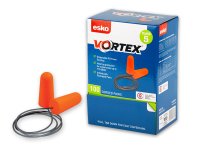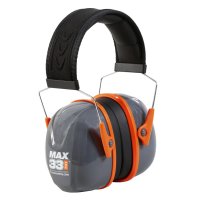
heaRING protection
Workplace Noise Levels
If workplace noise levels are too high, ambient sound will
permanently damage hearing. The risk depends on how loud the noise is and how
long a worker is exposed to it. Damage builds up gradually and changes will not be noticed
from one day to the next. But, once it occurs, noise damage is permanent and
there is no cure. In 2015 over 4,200 new claims were made with ACC for an ear
injury or loss of hearing suffered at work.
If exposure is kept to around 85 decibels (dB) over an eight hour working day (about the noise level of city traffic from inside a car) most people will suffer no long-term damage. But with more intense noise exposure, damage may occur in a shorter time. It’s important to know that the decibel scale is logarithmic, which means every increase of 3 dB doubles the sound level and with that increase it will take only half as long to damage your hearing.
Hearing depends on the delicate structures inside the ear
Decibel levels are often quoted as a dB(A), or A-weighted,
figure. This is an adjusted rating which compensates for the relative loudness
of sounds as perceived by the human ear. In this system, the decibel value of
low frequency sound is adjusted downwards compared with higher frequencies.
This reflects the way sound is perceived by the ear, which is less sensitive at
low audio frequencies, particularly below 1000Hz, than at higher frequencies.
Keeping Noise Exposure Down To 85 Db
All Esko hearing protection products meet the standard of AS/NZS 1270:2002 Acoustics—Hearing Protectors.
Products certified under the standard are given an SLC80 rating number. This number represents the decibel reduction that can be expected from that particular safety product. SLC stands for Sound Level Conversion and represents the level of protection achieved by 80% of test subjects.
Under the standard, workers should not be exposed to sound above 85dB for more than an 8-hour period. So, for instance, Esko’s MAX33 earmuff achieves an SLC80 rating of 33dB, meaning that the MAX33 will attenuate sound levels by 33dB. For example, take a worker who is exposed to a constant 110dB, about the noise level of small engine outdoor equipment. Wearing a MAX33 earmuff will reduce exposure to a safe 77dB (110dB - 33dB = 77dB). For convenience, under AS/NZS 1270:2002 the SLC80 ratings are ranked in a series of hearing protection classes, with 5 the highest level of protection.
Types of Hearing Protection
Disposable earplugs: These are usually made of soft expandable PU foam. The wearer rolls the plug between fingers to compress it before inserting it into the ear canal, and the plug expands again to seal against the individual contours of the wearer’s ear. These are economical, designed for single use and are available in uncorded and corded options. There is also a metal detectable version with a metalized cord and a metal tab in each plug that can be easily detected if they accidentally fall into processing lines. If used properly they are effective and comfortable but (a) will be ineffective if not inserted correctly, (b) may be a hygiene risk if rolled with dirty fingers and (c) could contribute to wax build up in the ear.
Reusable earplugs: These are moulded from washable soft plastic or silicone rubber and are usually ‘flanged’, with flexible ridges or flaps that circle the plug and enable it to seal gently against the ear canal. Corded and uncorded options are available. This type can be washed/cleaned if needed and reused.
Banded earplugs: A simple type of hearing protection with replaceable earplug pods linked by a plastic band. Typically, they may have a lower noise reduction rating than other ear protectors but are easy to put on and take off, therefore are ideal for intermittent use (moving in and out of noisy environments).
Earmuffs: Earmuffs suppress unwanted noise by completely covering the outer ear with a plastic shell filled with sound-deadening material to prevent noise reaching the inner ear. A variety of styles are available, including with adjustable headbands, Bluetooth connective and hard hat attachable. In general, earmuffs are slightly less effective than correctly fitted earplugs at frequencies up to 500Hz and are slightly more effective at higher frequencies.
Dual: Wearing earmuffs and earplugs together (dual protection) is not required by New Zealand regulators but does provide added protection, especially for workers in situations where noise exceeds 100 dBA. As a guide, allow 5-10 dB more noise reduction than either earmuffs or earplugs worn independently (the level of additional protection varies according to sound frequency).
By law, an employer has to ensure, as far as is reasonably practicable, that workers are not exposed to noise levels equivalent to 85 decibels or more (averaged over 8 hours) or any peak noise over 140 decibels. To ensure and document compliance will require setting up a hearing conservation program.
Step 1: Preliminary assessment of workplace noise levels
Identify possible noise hazards and assess the likely 8-hour noise exposure of a worker. Page 3 of this Worksafe guide
gives a good checklist for a preliminary noise survey. Noise measurement phone apps can be useful—they may not be 100% accurate but give a good indication. If a preliminary survey suggests noise levels might be over 84dB across an 8-hour period, a detailed assessment will be required. This is likely to need expert assistance from a health and safety consultant or occupational hygienist.
Step 2: Detailed assessment
If a preliminary survey suggests noise levels might be over 84dB across an 8-hour period, a detailed assessment will be required. Detailed noise assessments must be carried out by a competent person and this is likely to need assistance from a health and safety consultant or occupational hygienist. The assessment should:
- Quantify the amount of noise to which employees are exposed.
- Identify sources of noise.
- Assist in developing noise control strategies.
- Determine appropriate hearing protector needs.
Step 3: Control
Develop a noise control strategy to reduce workplace noise exposure to 85 dBA or below. Follow the hierarchy of the Health and Safety at Work Act 2015: eliminate, isolate, minimise:
- Eliminate
- As much as practicable, control noise at source, eg by using quieter machinery, fastening down loose panels, fitting anti-vibration mounts, etc.
- Isolate
- Move noise sources away from employees, enclose within sound-insulating surrounds.
- Minimise
- Where noise levels still exceed 85dB, use signage to designate zones where hearing protection is required to be worn (earplugs or earmuffs).
If hearing protection PPE is required:
- Educate staff about the need for hearing protection.
- Define hearing protection zones with signage.
- Provide staff with suitable options of hearing protector.
- Issue hearing protectors to staff. Check fit and appropriateness to individual users.
- Ensure hearing protectors are cleaned/replaced as necessary.
Step 5 - Monitoring
- Continue to monitor noise levels to ensure exposure remains below 85dB. An occupational hygienist or specially trained occupational health nurse should conduct testing:
- Arrange audiometry tests with an occupational health practitioner for workers.
- In areas with hazardous noise (above 85dB) this must be done when an employee starts work and at intervals of no more than 12 months afterwards.
- Worksafe has criteria for when hearing loss is ‘serious harm’. If audiometric testing reveals serious harm, Worksafe must be notified.
Noise in manufacturing
Many manufacturing processes, machinery and equipment produce high noise levels, which can lead to hearing problems.
> Find out more here
ACC's report on assessment and prevention
ACC’s report on assessing and preventing noise induced hearing loss in the workplace
View Report Here
Earmuffs with Class 5 Hearing Protection
What are my options for Earmuffs with Class 5 Hearing Protection?
See Options Here











